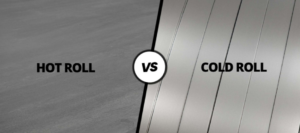Imagine that you are an architect designing a majestic skyscraper. You need to choose a type of steel to form the skeleton of this building. Would you choose hot-rolled steel or cold-rolled steel? Both cold rolled steel and hot rolled steel have their unique advantages and disadvantages. Let’s explore them together!

In general, the mechanical properties of hot-rolled steel are better than those of cold-rolled steel. After heat treatment, the tensile strength, yield strength, plasticity, and toughness of the steel will be improved. In addition, I feel that it is important that heat treatment can eliminate residual stresses, while cold rolling may cause uneven deformation of the steel during processing, resulting in residual stresses that have a significant impact on stability.
Both hot rolling and cold rolling are processes for forming steel shapes or steel plates, which have a significant impact on the structure and properties of steel. Hot rolling is the main method for steel rolling, while cold rolling is mainly used for producing small-sized steel shapes and thin plates.
Advantages of Hot Rolled Steel:
Hot rolling can destroy the casting structure of steel ingots, refine the grains of steel, and eliminate microstructure defects, thereby densifying the steel structure and improving its mechanical properties. This improvement is mainly reflected in the rolling direction, making the steel to some extent anisotropic; bubbles, cracks, and porosity formed during casting can also be welded under the action of high temperature and pressure.
Disadvantages of Hot Rolled Steel:
First, after hot rolling, the non-metallic inclusions (mainly sulfides, oxides, and silicates) inside the steel are pressed into thin sheets, resulting in delamination (sandwiching). Delamination greatly deteriorates the tensile properties of the steel along the thickness direction and may cause interlaminar tearing as the weld shrinks. The local strain induced by weld shrinkage often reaches several times the yield point strain, which is much larger than the strain caused by the load.
The second is the residual stress caused by uneven cooling. Residual stress is the internal self-balanced stress in the absence of external force. Hot-rolled steel sections of various sections have such residual stress. Generally, the larger the cross-section size of the section steel, the greater the residual stress. Although residual stress is self-balanced, it still has a certain impact on the performance of steel components under the action of external forces. For example, it may have adverse effects on deformation, stability, fatigue resistance, etc.
Advantages of Cold Rolled Steel:
Cold rolling refers to the processing of steel plates or strips into various types of steel shapes through cold drawing, cold bending, cold drawing, and other cold processes at room temperature. The advantages of cold rolling are its fast forming speed and high yield, without damaging the coating. It can be made into various cross-sectional forms to meet the needs of different usage conditions. Cold rolling can cause significant plastic deformation in steel, thereby increasing its yield point.
Disadvantages of Cold Rolled Steel:
First, although the forming process does not involve hot plastic compression, there is still residual stress in the cross-section, which necessarily affects the overall and local bending characteristics of the steel.
Second, cold rolled steel generally has an open cross-section, which results in a lower free torsional stiffness of the cross-section. It is prone to torsion during bending and bending-torsional buckling during compression, leading to poor torque performance.
Third, the wall thickness of cold rolled steel is relatively small, and there is no thickening at the corners where the boards connect. Therefore, it has a weak ability to withstand local concentrated loads.
What are the differences between cold rolled steel and hot rolled steel?
The main difference between hot rolled steel and cold rolled steel is:
- Cold-rolled steel allows local yielding of the cross-section, making it possible to fully utilize the load-bearing capacity after yielding. However, hot-rolled steel does not allow local yielding of the cross-section.
- The reasons for residual stress in hot rolled steel and cold rolled steel are different, resulting in a significant difference in the distribution of residual stress in the cross-section. The residual stress distribution in the cross-section of cold-bent thin-walled steel is bending type, while the residual stress distribution in hot-rolled steel or welded steel is film type.
Conclusion
Thank you for reading our article. We hope it can help you to have a better understanding of the advantages and disadvantages of cold rolled steel and hot rolled steel. If you want to learn more about cold-rolled stainless steel and hot-rolled stainless steel, we would like to advise you to visit Sino Stainless Steel for more information.
As a leading supplier of stainless steel products across the world, Sino Stainless Steel provides customers with high-quality stainless steel products such as Hot-rolled Stainless Coils, Cold-rolled Stainless Steel Coils, Polished Stainless Steel Coils, Stainless Steel Wires, Stainless Steel Tubes, and Precision Stainless Steel Sheets at a very competitive price.
 :+86-13012867759
:+86-13012867759  :export86@sino-stainless-steel.com
:export86@sino-stainless-steel.com